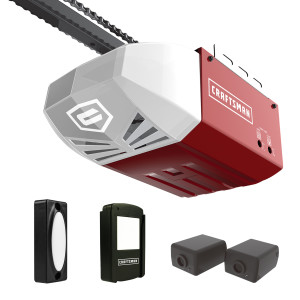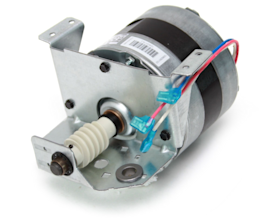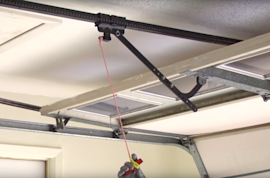Garage door opener common questions


These common questions about garage door openers are the ones our experts hear the most often from our customers. You might also find the help you need by checking the common symptoms and solutions for garage door openers. When you’re ready to make a repair, search your model number to find replacement parts. Sears PartsDirect has the part you need, no matter where you bought your garage door opener.
Why does my garage door reverse when I use the remote?
If something blocks the infrared beam between the safety sensors on either side of the door, the garage door reverses as a safety precaution. Remove anything in the path of the infrared beam.
Direct sun light hitting a sensor can also prevent the door from shutting. Install a safety sensor sun shield to prevent sunlight interference with the sensors.
If nothing is blocking the beam, check the sensors' alignment and aim them directly at each other. If the door still reverses, check the wires connecting the safety sensors to the motor unit on the garage door opener. If the problem persists, follow the advice in this garage door opener safety sensor troubleshooting video.
How do I test the garage door opener safety sensors?
Check the safety sensors for proper alignment. Then, with the garage door open, place a box or other obstruction between the safety sensors. Shut the door using a remote. The door should close slightly and then reverse.
If the door closes with the sensors blocked, replace the logic board because it isn't detecting the blocked sensors.
If the door won't close with the sensors aligned and unblocked, test the safety sensors at the motor unit of the garage door opener. To do so, cut short lengths of doorbell wire and strip the ends. Detach both safety sensors and use the wires to connect them directly to the motor unit. Hold the sensors so the sensor eyes face each other. Have a helper use the remote to close the door. If the garage door still won’t close, replace the sensors.
Why do my remotes work only when close to the motor?
Radio frequency (RF) interference from electronic devices can limit the range of a remote. Some garage door openers have a flexible antenna that you can adjust to try to eliminate the problem.
If the problem continues, locate and eliminate the source of the RF interference. Motion detectors on security lights or home alarm systems can cause RF interference. Electronic game consoles also can interfere with RF signals. If you're unable to find the source of RF interference, you can install an extension antenna on the side of your house to improve the reception.
Why can’t I program my garage door opener remotes?
Weak batteries can interfere with the programming function. Replace the batteries in all the remotes and the keyless entry pad.
If you still can’t program your remotes, erase all of the remote codes and re-program the remotes. With a universal remote, follow the programming steps provided. After pressing the program button on the remote, press the Learn button on the motor unit of your garage door opener. Press and release the button on the remote to operate the garage door opener. The garage door opener light blinks to indicate programming is complete. You might have to repeat pressing and releasing the remote button before the motor unit accepts the programming. For more information, check out our video on programming garage door opener remotes.
If you recently purchased new remotes, make sure the remotes are compatible with your model of garage door opener.
If the problem persists, radio frequency (RF) interference could be preventing the remotes from programming properly. Electronic eyes for automatic lights often cause RF interference. Ham radios and other electronics could be the source. Some types of LED light bulbs can cause RF interference.
Sometimes you'll need special programming to link a vehicle's built-in remote control to the garage door opener. First, follow the steps in the vehicle owner's manual for clearing any existing codes and then program the vehicle's remote control device. If you still can't program the vehicle's built-in remote, contact the manufacturer of the garage door opener for a software update that may be available to correct incompatibility.
How do I open my garage door during a power outage?
The garage door opener has an emergency release cord attached to the trolley. Pull the cord to release the trolley from the garage door. You can then open and close the garage door manually.
How heavy a door can my 1/2-HP garage door opener lift?
A 1/2-horsepower garage door opener can lift a door up to 18 feet wide and 8 feet high, weighing up to 300 pounds. Because the garage door springs lift most of the weight of the door, the garage door opener itself only exerts the same force you use to open the garage door by hand.
How heavy a door can my 3/4-HP garage door opener lift?
A 3/4-horsepower garage door opener can lift a door up to 18 feet wide and 10 feet high, weighing up to 350 pounds. Because the garage door springs lift most of the weight of the door, the garage door opener itself only exerts the same force you use to open the garage door by hand.
Why does my garage door reverse as soon as it hits the floor?
Check the garage door opener down travel limit. The door reverses if it hits an immovable object during down travel. If you set the down travel limit too far, the garage door opener continues to close the door until the door hits the floor and then the garage door opener reverses to open the door since it hit an immovable object.
If you're not able to program the down travel to stop when the door closes, then the garage door opener could have a defective limit switch, a wiring failure or a faulty logic board. Check out our video for more on travel troubleshooting.
Can I program my remote to open more than one garage door?
Most garage door opener remotes have 3 activation buttons. You can program each of the universal remote’s three buttons to open a different garage door. You’ll need to choose a new button for each garage door opener. Unfortunately, most remotes won’t let you program one button to activate two door openers at the same time.
Also, if you have different models of garage door opener installed in your home, make sure the remote that you program is compatible with all your models. Universal remotes are available for most garage door opener models. Universal remotes work with almost all models. Purchase a universal remote to program one device to operate garage door openers that use incompatible, original remotes.
Why can't I program my garage door opener's universal remote?
Universal remotes often require a different programming procedure than your original remote device. Follow the instructions provided with the universal remote. Most universal remotes have a small programming button on the back of the device that you must press to begin the programming procedure.
Also, universal remotes often require more than one attempt to link the remote device to your garage door opener. If you press the universal remote button and the garage door opener lights don't blink to indicate the garage door opener accepted the programming, press the remote button a second time. Don't forget to press a different remote button to complete the universal remote programming once the garage door opener lights blink.
Watch our garage door opener remote programming video for more help programming your universal remote.
Most common symptoms to help you fix your garage door openers
Choose a symptom to see related garage door opener repairs.
Main causes: faulty logic control board, bad RPM sensor, broken gears in the drive system, bad drive motor…
Main causes: radio interference, weak remote batteries, sunlight interference with safety sensor beams, safety sensors n…
Things to do: check garage door travel, tighten brackets and fasteners, test safety sensors, check travel limits and for…
Main causes: garage door locked, damaged garage door tracks, up-force setting needs adjustment, RPM sensor failure, bad …
Main causes: neighbor's remote programmed at the same time as yours, faulty wall control wiring, bad wall control unit…
Main causes: garage door opener misaligned, travel limits need adjustment, bad travel limit switches, faulty logic contr…
Main causes: safety sensor beams blocked, safety sensors not aligned, downforce setting needs adjustment, damaged garage…
Main causes: loose fasteners, broken brackets, need preventive maintenance, worn drive gears, loose or worn belt, loose …
Most common repair guides to help fix your garage door openers
These step-by-step repair guides will help you safely fix what’s broken on your garage door opener.

How to replace a chain-drive garage door opener motor
Get your garage door moving again by replacing a defective motor in your garage door opener.…

How to replace a belt-drive garage door opener motor
The garage door won't move if the motor is defective. Here’s how to fix it.…

How to replace a garage door opener drive chain and cable assembly
If your garage door won’t move, the chain and cable assembly on your garage door opener could be broken. Follow these st…
Effective articles & videos to help repair your garage door openers
Use the advice and tips in these articles and videos to get the most out of your garage door opener.

Learn about all the convenient features on our Sears PartsDirect website that make your parts purchases easier.…

Get answers to frequently asked questions about Sears and Sears PartsDirect.…

Learn how to open a garage door manually if power to your garage door opener fails.…
